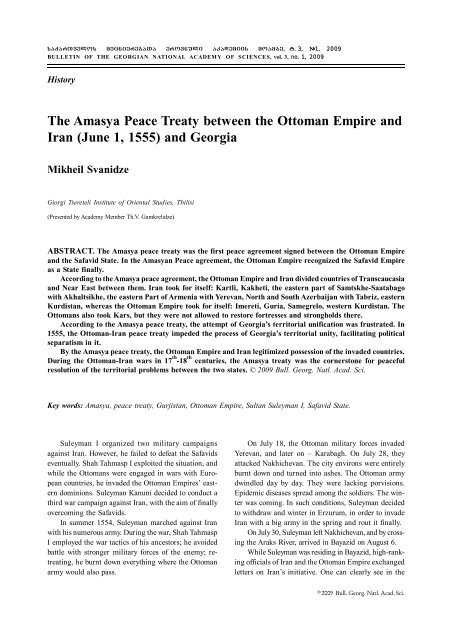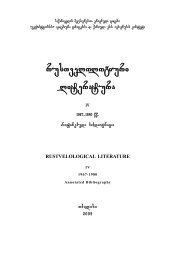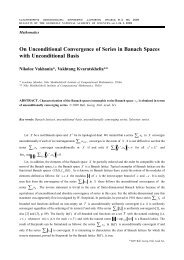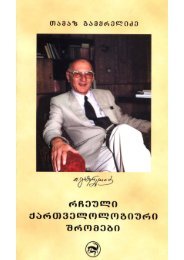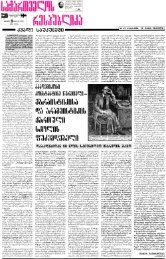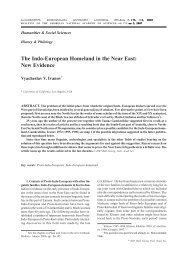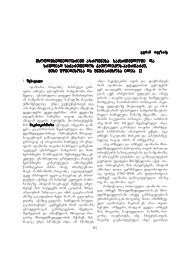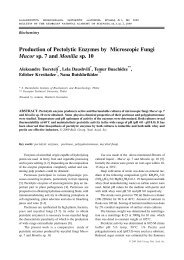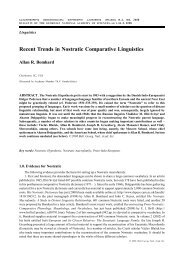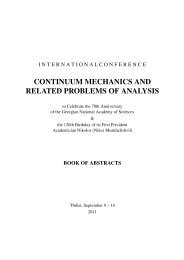The Amasya Peace Treaty between the Ottoman Empire and Iran ...
The Amasya Peace Treaty between the Ottoman Empire and Iran ...
The Amasya Peace Treaty between the Ottoman Empire and Iran ...
Create successful ePaper yourself
Turn your PDF publications into a flip-book with our unique Google optimized e-Paper software.
saqarTvelos mecnierebaTa erovnuli akademiis moambe, t. 3, #1, 2009<br />
BULLETIN OF THE GEORGIAN NATIONAL ACADEMY OF SCIENCES, vol. 3, no. 1, 2009<br />
History<br />
<strong>The</strong> <strong>Amasya</strong> <strong>Peace</strong> <strong>Treaty</strong> <strong>between</strong> <strong>the</strong> <strong>Ottoman</strong> <strong>Empire</strong> <strong>and</strong><br />
<strong>Iran</strong> (June 1, 1555) <strong>and</strong> Georgia<br />
Mikheil Svanidze<br />
Giorgi Tsereteli Institute of Oriental Studies, Tbilisi<br />
(Presented by Academy Member Th.V. Gamkrelidze)<br />
ABSTRACT. <strong>The</strong> <strong>Amasya</strong> peace treaty was <strong>the</strong> first peace agreement signed <strong>between</strong> <strong>the</strong> <strong>Ottoman</strong> <strong>Empire</strong><br />
<strong>and</strong> <strong>the</strong> Safavid State. In <strong>the</strong> <strong>Amasya</strong>n <strong>Peace</strong> agreement, <strong>the</strong> <strong>Ottoman</strong> <strong>Empire</strong> recognized <strong>the</strong> Safavid <strong>Empire</strong><br />
as a State finally.<br />
According to <strong>the</strong> <strong>Amasya</strong> peace agreement, <strong>the</strong> <strong>Ottoman</strong> <strong>Empire</strong> <strong>and</strong> <strong>Iran</strong> divided countries of Transcaucasia<br />
<strong>and</strong> Near East <strong>between</strong> <strong>the</strong>m. <strong>Iran</strong> took for itself: Kartli, Kakheti, <strong>the</strong> eastern part of Samtskhe-Saatabago<br />
with Akhaltsikhe, <strong>the</strong> eastern Part of Armenia with Yerevan, North <strong>and</strong> South Azerbaijan with Tabriz, eastern<br />
Kurdistan, whereas <strong>the</strong> <strong>Ottoman</strong> <strong>Empire</strong> took for itself: Imereti, Guria, Samegrelo, western Kurdistan. <strong>The</strong><br />
<strong>Ottoman</strong>s also took Kars, but <strong>the</strong>y were not allowed to restore fortresses <strong>and</strong> strongholds <strong>the</strong>re.<br />
According to <strong>the</strong> <strong>Amasya</strong> peace treaty, <strong>the</strong> attempt of Georgia’s territorial unification was frustrated. In<br />
1555, <strong>the</strong> <strong>Ottoman</strong>-<strong>Iran</strong> peace treaty impeded <strong>the</strong> process of Georgia’s territorial unity, facilitating political<br />
separatism in it.<br />
By <strong>the</strong> <strong>Amasya</strong> peace treaty, <strong>the</strong> <strong>Ottoman</strong> <strong>Empire</strong> <strong>and</strong> <strong>Iran</strong> legitimized possession of <strong>the</strong> invaded countries.<br />
During <strong>the</strong> <strong>Ottoman</strong>-<strong>Iran</strong> wars in 17 th -18 th centuries, <strong>the</strong> <strong>Amasya</strong> treaty was <strong>the</strong> cornerstone for peaceful<br />
resolution of <strong>the</strong> territorial problems <strong>between</strong> <strong>the</strong> two states. © 2009 Bull. Georg. Natl. Acad. Sci.<br />
Key words: <strong>Amasya</strong>, peace treaty, Gurjistan, <strong>Ottoman</strong> <strong>Empire</strong>, Sultan Suleyman I, Safavid State.<br />
Suleyman I organized two military campaigns<br />
against <strong>Iran</strong>. However, he failed to defeat <strong>the</strong> Safavids<br />
eventually. Shah Tahmasp I exploited <strong>the</strong> situation, <strong>and</strong><br />
while <strong>the</strong> <strong>Ottoman</strong>s were engaged in wars with European<br />
countries, he invaded <strong>the</strong> <strong>Ottoman</strong> <strong>Empire</strong>s’ eastern<br />
dominions. Suleyman Kanuni decided to conduct a<br />
third war campaign against <strong>Iran</strong>, with <strong>the</strong> aim of finally<br />
overcoming <strong>the</strong> Safavids.<br />
In summer 1554, Suleyman marched against <strong>Iran</strong><br />
with his numerous army. During <strong>the</strong> war, Shah Tahmasp<br />
I employed <strong>the</strong> war tactics of his ancestors; he avoided<br />
battle with stronger military forces of <strong>the</strong> enemy; retreating,<br />
he burnt down everything where <strong>the</strong> <strong>Ottoman</strong><br />
army would also pass.<br />
On July 18, <strong>the</strong> <strong>Ottoman</strong> military forces invaded<br />
Yerevan, <strong>and</strong> later on – Karabagh. On July 28, <strong>the</strong>y<br />
attacked Nakhichevan. <strong>The</strong> city environs were entirely<br />
burnt down <strong>and</strong> turned into ashes. <strong>The</strong> <strong>Ottoman</strong> army<br />
dwindled day by day. <strong>The</strong>y were lacking porvisions.<br />
Epidemic diseases spread among <strong>the</strong> soldiers. <strong>The</strong> winter<br />
was coming. In such conditions, Suleyman decided<br />
to withdraw <strong>and</strong> winter in Erzurum, in order to invade<br />
<strong>Iran</strong> with a big army in <strong>the</strong> spring <strong>and</strong> rout it finally.<br />
On July 30, Suleyman left Nakhichevan, <strong>and</strong> by crossing<br />
<strong>the</strong> Araks River, arrived in Bayazid on August 6.<br />
While Suleyman was residing in Bayazid, high-ranking<br />
officials of <strong>Iran</strong> <strong>and</strong> <strong>the</strong> <strong>Ottoman</strong> <strong>Empire</strong> exchanged<br />
letters on <strong>Iran</strong>’s initiative. One can clearly see in <strong>the</strong><br />
© 2009 Bull. Georg. Natl. Acad. Sci.
192 Mikheil Svanidze<br />
correspondence that in spite of rebuking each o<strong>the</strong>r, <strong>the</strong><br />
sides were interested in restoring peace [1: 315-317; 2:<br />
46, 47; 3: 65-67; 4: 228].<br />
<strong>The</strong> peace negotiations that started in a written format<br />
in Bayazid were continued later on. This laid <strong>the</strong><br />
foundation for <strong>the</strong> future <strong>Ottoman</strong>-<strong>Iran</strong> peace talks.<br />
Nei<strong>the</strong>r did <strong>the</strong> third military campaign bring <strong>the</strong><br />
desired results to Sultan Suleyman, <strong>and</strong> hence he embarked<br />
on <strong>the</strong> road of reconciliation [1: 316, 317; 3: 66-<br />
69; 5: 34].<br />
After leaving Bayazid on August 9, Suleyman arrived<br />
in Erzurum <strong>and</strong> encamped with his army near to<br />
<strong>the</strong> bordering Sazlık.<br />
On September 26, Shah Tahmasp’s ambassador<br />
Korchi Bash Shah Kulu arrived in Erzurum. He offered<br />
peace to <strong>the</strong> Sultan Suleyman in <strong>the</strong> name of <strong>the</strong> Shah.<br />
On September 27, 1554 <strong>the</strong> sides signed an agreement<br />
on temporary peace in Erzurum (Sazlık) [1:70; 2:<br />
4-6; 4: 239].<br />
<strong>The</strong> armistice entailed territorial division: “Since<br />
1534, Basra, Baghdad, Shahrizur, Bitlis, Van, Erzurum,<br />
Kars <strong>and</strong> Atabag’s country that were invaded by <strong>the</strong><br />
Kizilbash belong to <strong>the</strong> territory of <strong>the</strong> <strong>Ottoman</strong> <strong>Empire</strong>,<br />
<strong>and</strong> thus it cannot be claimed by o<strong>the</strong>rs” [4: 240].<br />
This clearly shows that <strong>the</strong> territories mentioned in <strong>the</strong><br />
text belonged to <strong>the</strong> <strong>Ottoman</strong>s.<br />
It was also in <strong>the</strong> same manner that <strong>the</strong> <strong>Ottoman</strong><br />
<strong>and</strong> Safavid empires divided Georgia into <strong>the</strong>ir spheres<br />
of influence: Meskheti, Kartli <strong>and</strong> Kakheti were taken<br />
over by <strong>Iran</strong>, <strong>and</strong> Imereti, Samegrelo <strong>and</strong> Guria up to<br />
<strong>the</strong> border of Trabzon became part of <strong>the</strong> <strong>Ottoman</strong><br />
<strong>Empire</strong>. [6:450].<br />
If <strong>Iran</strong>’s Shah did not comply with <strong>the</strong> conditions of<br />
<strong>the</strong> treaty of Erzurum, Suleyman threatened to conduct<br />
a war campaign against <strong>Iran</strong> once again <strong>and</strong> to destroy<br />
Tabriz <strong>and</strong> Ardebil [3: 70; 4:240].<br />
Thus, <strong>the</strong>y settled <strong>the</strong> main disputed territorial issues<br />
as a result of <strong>the</strong> Erzurum peace negotiations. <strong>The</strong><br />
temporary peace conditions were valid until signing <strong>the</strong><br />
ultimate peace treaty. Later on, in 1555 <strong>the</strong> conditions<br />
were approved by <strong>the</strong> peace agreement of Erzurum.<br />
After reaching an agreement, <strong>the</strong> ambassador of <strong>Iran</strong><br />
promised <strong>the</strong> Sultan that within a month Shah Tahmasp<br />
would send him a new ambassador who would be authorized<br />
to sign <strong>the</strong> peace treaty with him [2: VI, 48; 7:<br />
40; 8: II, 361].<br />
On September 28, Suleyman I left Erzurum, heading<br />
for <strong>Amasya</strong>, where he arrived on October 30, <strong>and</strong><br />
wintered <strong>the</strong>re. <strong>The</strong> Persians suspected this as a prelude<br />
to <strong>the</strong> renewal of war in spring by <strong>the</strong> army stationed in<br />
<strong>Amasya</strong>. <strong>The</strong>ir suspicion was not groundless; usually,<br />
Bull. Georg. Natl. Acad. Sci., vol. 3, no. 1, 2009<br />
when <strong>the</strong> Sultan did not return to <strong>the</strong> capital after conducting<br />
a war operation <strong>and</strong> instead stayed in one of <strong>the</strong><br />
towns of Anatolia, he began war next spring. This happened,<br />
for example, in <strong>the</strong> 1514-1515, 1534-1535 <strong>and</strong><br />
1548-1549 wars with <strong>Iran</strong>.<br />
At <strong>the</strong> same time, on <strong>the</strong> one h<strong>and</strong>, Shah Tahmasp’s<br />
campaign in Kartli against King Luarsab I <strong>and</strong>, on <strong>the</strong><br />
o<strong>the</strong>r, <strong>the</strong> Persians’ attack on <strong>the</strong> garrison stationed in<br />
Samtskhe-Saatabago aggravated <strong>the</strong> <strong>Ottoman</strong>-<strong>Iran</strong>ian<br />
relations. Thus, it was expected that in <strong>the</strong> spring of <strong>the</strong><br />
next year, <strong>the</strong> Sultan would renew war operations against<br />
<strong>Iran</strong>, in which Georgia would play a significant part, as<br />
it did earlier, in 1549. Besides, taking into consideration<br />
that <strong>the</strong> king of Kartli sought refuge from Shah<br />
Tahmasp in Imereti, <strong>and</strong> <strong>the</strong> fact that <strong>the</strong> Imeretian king<br />
Bagrat III asked for <strong>the</strong> Sultan’s support due to <strong>the</strong> Shah’s<br />
threats, also streng<strong>the</strong>ned <strong>the</strong> suspicion of <strong>the</strong> Persians.<br />
<strong>The</strong>refore, at <strong>the</strong> <strong>Iran</strong>ian court, no one hurried to send<br />
an ambassador to <strong>the</strong> Sultan. <strong>The</strong>y, instead, tried to<br />
negotiate <strong>the</strong> matter officially with <strong>the</strong> <strong>Ottoman</strong>s at a<br />
lower level. A very important document has been found<br />
regarding <strong>the</strong> matter, which belongs to Shah Tahmasp’s<br />
high officials’ “Sevindük Bey <strong>and</strong> Ustajlu Shah-Kulu<br />
Ben Hamza. <strong>The</strong> letter was sent to an influential Turkish<br />
official, Erzurum’s Beylerbey“ Aias Pasha. In accordance<br />
with its content, L. Fekete assumes that it must<br />
have been written after August 1554 despite <strong>the</strong> fact<br />
that <strong>the</strong> letter has no date [9: 93-133; 10: 412-420].<br />
Suleyman’s arrival at <strong>Amasya</strong> is mentioned in this<br />
letter [9:132; 10: 412-429]. In my view, <strong>the</strong> letter might<br />
have been composed a little later, after Suleyman arrived<br />
at <strong>Amasya</strong>, e. g., after October 30, 1554.<br />
On May 10, in 1555, <strong>the</strong> embassy of <strong>Iran</strong> arrived at<br />
<strong>Amasya</strong>. <strong>The</strong> ambassador, Ferukhzade Beg had been<br />
authorized by <strong>the</strong> Shah of <strong>Iran</strong> to sign a peace treaty<br />
with <strong>the</strong> <strong>Ottoman</strong> <strong>Empire</strong>. <strong>The</strong> delegation of <strong>Iran</strong> was<br />
welcomed with delight in <strong>Amasya</strong>. <strong>The</strong>y were accommodated<br />
at a specially chosen palace, <strong>and</strong> were hosted<br />
exuberantly. However, <strong>the</strong> ambassador, for his part, had<br />
brought with him luxurious presents: expensive carpets,<br />
tents with embroidered inner surface, curved saddle girth,<br />
unique swords of Damascus, gorgeous lances <strong>and</strong> shields,<br />
etc. However, all <strong>the</strong>se presents were shadowed by a<br />
fabulously copied Koran. By <strong>the</strong> comm<strong>and</strong> of <strong>the</strong> Sultan<br />
Suleyman, <strong>the</strong> Gr<strong>and</strong> Vizier <strong>and</strong> <strong>the</strong> rest of <strong>the</strong> viziers<br />
held receptions <strong>and</strong> parties [1: 329; 3: 72; 4: 241; 5: 5].<br />
On May 21, <strong>the</strong> sitting of <strong>the</strong> Sultan’s Divan (Divänı<br />
Hümayüm) was held. <strong>The</strong> <strong>Ottoman</strong> viziers, <strong>the</strong> ambassador<br />
of <strong>Iran</strong> <strong>and</strong> members of <strong>the</strong> delegation attended<br />
<strong>the</strong> sitting. <strong>The</strong>y held a discussion of <strong>the</strong> terms <strong>and</strong><br />
conditions of <strong>the</strong> peace agreement <strong>between</strong> <strong>the</strong> <strong>Ottoman</strong>
<strong>The</strong> <strong>Amasya</strong> <strong>Peace</strong> <strong>Treaty</strong> <strong>between</strong> <strong>the</strong> <strong>Ottoman</strong> <strong>Empire</strong> <strong>and</strong> <strong>Iran</strong> (June 1, 1555) <strong>and</strong> Georgia 193<br />
<strong>and</strong> Safavid states. <strong>The</strong> ambassador of <strong>Iran</strong> h<strong>and</strong>ed <strong>the</strong><br />
Padishah a letter from Shah Tahmasp, which was full of<br />
cautious, splendid <strong>and</strong> gr<strong>and</strong>iloquent words revealing<br />
<strong>the</strong> Shah’s will to bring Samtskhe-Saatabago (Principality<br />
of Samtskhe) under <strong>Iran</strong>’s dependence [1: 319; 3:<br />
72, 73; 4: 241, 242; 11: II, 293, 294].<br />
<strong>The</strong> question of fixing <strong>the</strong> border <strong>between</strong> <strong>the</strong> two<br />
states was solved, based on <strong>the</strong> Uti possidetis principle,<br />
e.g., <strong>the</strong> <strong>Ottoman</strong> side retained its territories that it owned<br />
at <strong>the</strong> time before signing <strong>the</strong> peace treaty.<br />
According to <strong>the</strong> peace agreement of <strong>Amasya</strong>, <strong>The</strong><br />
<strong>Ottoman</strong> <strong>Empire</strong> <strong>and</strong> <strong>Iran</strong> divided Georgia <strong>between</strong><br />
<strong>the</strong>mselves in <strong>the</strong> following manner: Kakheti, Mosuki,<br />
Akhaltsikhe, Akhalkalaki, Okros Tsikhe (also known as<br />
Altunkala), Borchalo, Kartli, Tbilisi, Gori, Surami,<br />
Meskheti were taken by <strong>Iran</strong>, <strong>and</strong> Bashiachuki (Imereti),<br />
Dadiani (Samegrelo), Guria, Part of Saatabago “ Dadeli<br />
(Tao), Ardahani, Artanuji, Oltisi, Tortumi were taken<br />
by <strong>the</strong> <strong>Ottoman</strong> State from <strong>the</strong> bank of <strong>the</strong> Chorokhi<br />
River to <strong>the</strong> border with Trabzon [3: 72; 4: 241, 242;<br />
12: II, 906].<br />
After <strong>the</strong> meeting of <strong>the</strong> Divan ended, a reception<br />
was held, during which <strong>the</strong> embassy of <strong>Iran</strong> delivered<br />
luxurious presents to <strong>the</strong> <strong>Ottoman</strong> side. Later on, <strong>the</strong><br />
Padishah came in person to <strong>the</strong> Divan bureau, <strong>and</strong> <strong>the</strong><br />
viziers <strong>and</strong> <strong>the</strong> delegation sent from <strong>the</strong> Shah paid a<br />
visit to him. <strong>The</strong> latter delivered to him <strong>the</strong> Shah’s highly<br />
skilled letter composed in brilliant words. After <strong>the</strong> Divan<br />
was ended, <strong>the</strong> Padishah ordered his first, second <strong>and</strong><br />
third viziers to host <strong>the</strong> <strong>Iran</strong>ian embassy on <strong>the</strong> subsequent<br />
days one after <strong>the</strong> o<strong>the</strong>r.<br />
After <strong>the</strong> bilateral negotiations <strong>between</strong> <strong>Ottoman</strong>s<br />
<strong>and</strong> <strong>the</strong> delegation of <strong>Iran</strong>, <strong>the</strong> border <strong>between</strong> <strong>the</strong> two<br />
states was affirmed as it was according to <strong>the</strong> last <strong>Ottoman</strong><br />
conquests, by which - Artaani, Kars, Gole,<br />
Arpachai’s environs etc. came under Turkish dominion<br />
[3: 72; 11: II, 294; 13: 349].<br />
In <strong>Amasya</strong>, toge<strong>the</strong>r with <strong>the</strong> representatives of <strong>the</strong><br />
<strong>Ottoman</strong> <strong>Empire</strong>, those of different states also arrived.<br />
Some of <strong>the</strong>m were interested in <strong>the</strong> successful accomplishment<br />
of <strong>the</strong> peace talks <strong>between</strong> <strong>the</strong> <strong>Ottoman</strong> State<br />
<strong>and</strong> <strong>Iran</strong>, but o<strong>the</strong>rs were trying to hold <strong>the</strong> talks back.<br />
For example, <strong>the</strong> ambassador of France, M.<br />
Codignac arrived in <strong>Amasya</strong> with <strong>the</strong> intention of supporting<br />
<strong>Ottoman</strong>-<strong>Iran</strong> peace. According to an agreement<br />
signed with Turkey in 1553, France expected assistance<br />
from <strong>the</strong> <strong>Ottoman</strong>s if peace was achieved by <strong>the</strong> two<br />
sides [11: II, 233; 14: 97].<br />
M. Codignac, in his letter sent from <strong>Amasya</strong> to <strong>the</strong><br />
king of France on May 10, about ongoing negotiations<br />
Bull. Georg. Natl. Acad. Sci., vol. 3, no. 1, 2009<br />
aimed at achieving peace <strong>between</strong> <strong>Iran</strong> <strong>and</strong> <strong>the</strong> <strong>Ottoman</strong>s.<br />
<strong>The</strong> ambassador of France supported <strong>the</strong> <strong>Iran</strong>-<br />
<strong>Ottoman</strong> peace by all means. At <strong>the</strong> same time, he was<br />
hindering <strong>the</strong> negotiations <strong>between</strong> <strong>the</strong> ambassador of<br />
Austria, Busbeq, <strong>and</strong> <strong>the</strong> Sultan [15:558; 16: 176].<br />
For <strong>the</strong>ir part, <strong>the</strong> Hungarian diplomats knew very<br />
well that if a peace treaty was signed by <strong>the</strong> <strong>Ottoman</strong><br />
<strong>Empire</strong> <strong>and</strong> <strong>Iran</strong>, <strong>the</strong>y would lose an opportunity of signing<br />
a peace agreement with <strong>the</strong> <strong>Ottoman</strong>s. For this obvious<br />
reason <strong>the</strong>y were advising Ferdin<strong>and</strong> to agree to a<br />
compromise with <strong>the</strong> Sultan <strong>and</strong> to speed up <strong>the</strong> peace<br />
process <strong>between</strong> <strong>the</strong> <strong>Ottoman</strong> <strong>Empire</strong> <strong>and</strong> Hungary.<br />
On January 20, 1555, Ferdin<strong>and</strong>’s Austrian ambassador,<br />
A. Busbeq arrived in Istanbul <strong>and</strong> brought new<br />
instructions that in <strong>the</strong> end did not satisfy <strong>the</strong> debating<br />
sides. <strong>The</strong> core idea of <strong>the</strong> newly brought directives was<br />
to maintain Transylvania <strong>and</strong> sign <strong>the</strong> truce with <strong>the</strong><br />
<strong>Ottoman</strong> <strong>Empire</strong>. In <strong>Amasya</strong>, <strong>the</strong> Sultan was notified<br />
about Ferdin<strong>and</strong>’s new offer. <strong>The</strong> <strong>Ottoman</strong> Sultan immediately<br />
ordered to send <strong>the</strong> ambassador of <strong>the</strong> Hungarian<br />
King to him [16:176].<br />
On April 7, A. Busbeq, A. Verancsics <strong>and</strong> F. Zay<br />
arrived in <strong>Amasya</strong>. <strong>The</strong> Hungarian diplomats were instantly<br />
received by <strong>the</strong> Gr<strong>and</strong> Vizier Ahmed Pasha <strong>and</strong><br />
later on, by <strong>the</strong> Sultan himself. According to Busbeq,<br />
<strong>the</strong> Sultan had a dissatisfied <strong>and</strong> strict expression on his<br />
face. After delivering a welcoming speech, Busbeq asked<br />
<strong>the</strong> Sultan if he recognized Ferdin<strong>and</strong>’s right to<br />
Transylvania, <strong>and</strong> <strong>the</strong> Sultan’s look became even more<br />
severe <strong>and</strong> he added with a bitter tone: “All right, all<br />
right”. <strong>The</strong> audience ended in this manner [17: 125].<br />
<strong>The</strong> Hungarian diplomats met many influential officials<br />
<strong>and</strong> promised <strong>the</strong>m reward in gold in case <strong>the</strong>y<br />
helped <strong>the</strong>m in achieving <strong>the</strong>ir goal by influencing <strong>the</strong><br />
Sultan, but <strong>the</strong>ir attempts failed.<br />
It is worth noting that <strong>the</strong> Hungarian diplomats met<br />
representatives of <strong>the</strong> Georgian kingdom in <strong>Amasya</strong><br />
[16:176].<br />
<strong>The</strong>re was a sharp diplomatic dispute <strong>between</strong> <strong>the</strong><br />
representatives of France <strong>and</strong> Hungary. Codignac, <strong>the</strong><br />
ambassador of France, was interested in <strong>the</strong> <strong>Iran</strong>ian-<br />
<strong>Ottoman</strong> peace. However, <strong>the</strong> Hungarian diplomats, on<br />
<strong>the</strong> contrary, did not wish for it. <strong>The</strong> ambassador of<br />
France was notably participating in <strong>the</strong> business of <strong>the</strong><br />
<strong>Iran</strong>ian-<strong>Ottoman</strong> peace talks [18: I, 55].<br />
At this stage of <strong>the</strong> war with <strong>Iran</strong>, Sultan Suleyman<br />
was bored with <strong>the</strong> unsuccessful campaigns against <strong>Iran</strong>,<br />
which required a large amount of material resources.<br />
He remembered with delight his victories in Europe <strong>and</strong><br />
decided to end <strong>the</strong> war. At <strong>the</strong> court of <strong>the</strong> Sultan, <strong>the</strong>
194 Mikheil Svanidze<br />
eastern policy lost its actuality <strong>and</strong> <strong>the</strong> “question of<br />
Gurjestan” no longer constituted a problem of state significance<br />
for <strong>the</strong>m [9: 190].<br />
<strong>The</strong> ambassadors of <strong>the</strong> Emperor of Austria <strong>and</strong> <strong>the</strong><br />
King of Hungary were not interested in <strong>the</strong> positive resolution<br />
of <strong>the</strong> <strong>Ottoman</strong>-<strong>Iran</strong>ian peace talks. A. Verancsics<br />
<strong>and</strong> F. Zay tried <strong>the</strong>ir best to wreck <strong>the</strong> negotiations.<br />
<strong>The</strong>y persuaded influential <strong>Ottoman</strong> officials to push<br />
<strong>the</strong> Sultan tacitly towards signing <strong>the</strong> peace treaty with<br />
Hungary, which would allow <strong>the</strong> Sultan to throw his<br />
entire forces against <strong>the</strong> Persians <strong>and</strong> <strong>the</strong>ir Georgian<br />
allies [19: 221].<br />
<strong>The</strong>re is no doubt that Ferdin<strong>and</strong>’s short-sighted<br />
policy proved to be fatal for his state. By his persistence,<br />
he achieved only an anti-result; <strong>the</strong> Sultan favored <strong>the</strong><br />
peace with Asia ra<strong>the</strong>r than with Hungary, <strong>and</strong> thus<br />
acquired an opportunity of free action in <strong>the</strong> latter country.<br />
<strong>The</strong> representatives of Hungary, despite all of <strong>the</strong>ir<br />
diplomatic attempts, expensive presents <strong>and</strong> tribute paid<br />
for Transylvania, managed to achieve only a temporary<br />
truce [16: 191]. On May 31, 1555 <strong>the</strong> Sultan sent a<br />
letter to Ferdin<strong>and</strong>, requesting restoration of Janosh<br />
Zhigmond’s hereditary rights [20: II, 50-54].<br />
On June 1, 1555, <strong>the</strong> last meeting of <strong>the</strong> Divänı<br />
Hümayüm was held in <strong>Amasya</strong>, at which <strong>the</strong> <strong>Ottoman</strong>-<br />
<strong>Iran</strong>ian peace treaty was finally signed. At <strong>the</strong> same<br />
time, Suleyman Kanuni sent a letter to Shah Tahmasp,<br />
in which he stressed with delight <strong>the</strong> significance of <strong>the</strong><br />
peace achieved <strong>between</strong> <strong>the</strong> two states. He approved <strong>the</strong><br />
appeal of Shah Tahmasp by emphasizing <strong>the</strong> following:<br />
Unless, <strong>the</strong> <strong>Iran</strong>ians violate <strong>the</strong> conditions of <strong>the</strong> treaty,<br />
<strong>the</strong> <strong>Ottoman</strong>s would maintain peace <strong>and</strong> not apply to<br />
those actions that may cause conflict <strong>between</strong> <strong>the</strong> border<br />
chiefs.<br />
Suleyman Kanuni allowed Shah Tahmasp free pilgrimage<br />
of <strong>the</strong> <strong>Iran</strong>ian believers to <strong>the</strong> holy places of his<br />
<strong>Empire</strong> <strong>and</strong> guaranteed security to <strong>the</strong>m [3: 86, 87; 13:<br />
349].<br />
Towards <strong>the</strong> close of <strong>the</strong> letter, he conveyed his<br />
protestations of friendship <strong>and</strong> asked <strong>the</strong> Shah to give a<br />
thought to <strong>the</strong> following three conditions offered by him:<br />
“Firstly, <strong>the</strong> conscience of <strong>the</strong> followers of <strong>the</strong> Prophet<br />
Muhammad will be protected. Secondly, unless sedition<br />
<strong>and</strong> unrest occur from <strong>the</strong> opposite side, <strong>the</strong> <strong>Ottoman</strong><br />
forces would not violate <strong>the</strong> borders. Thirdly, request of<br />
<strong>the</strong> pilgrims that each Muslim can freely visit <strong>and</strong> venerate<br />
holy places in <strong>the</strong> <strong>Ottoman</strong> <strong>Empire</strong>” [3: 86, 87;<br />
13: 349].<br />
Bull. Georg. Natl. Acad. Sci., vol. 3, no. 1, 2009<br />
During <strong>the</strong> peace talks, much attention was paid to<br />
reducing existing religious controversies <strong>between</strong> Shiism<br />
<strong>and</strong> Sunnism. <strong>The</strong> Sultan recognized <strong>the</strong> vassals of <strong>the</strong><br />
Shah as followers of <strong>the</strong> ‘veritable faith’ <strong>and</strong> allowed<br />
<strong>the</strong>m to visit <strong>the</strong> holy places Mecca <strong>and</strong> Medina. <strong>The</strong><br />
Sultan also proposed stopping abuse <strong>and</strong> defamation of<br />
<strong>the</strong> first three Caliphs <strong>and</strong> Aishe by <strong>Iran</strong>’s side.<br />
Before leaving <strong>Amasya</strong>, Sultan Suleyman sent<br />
firmans to <strong>the</strong> Governors of <strong>the</strong> bordering provinces of<br />
<strong>Iran</strong>, in which he notified <strong>the</strong>m about <strong>the</strong> peace treaty.<br />
In Turkish historiography it was accepted that <strong>the</strong><br />
<strong>Amasya</strong> peace treaty was signed on May 29, 1555. Evidence<br />
on this is to be found in <strong>the</strong> well-known work of<br />
J. Hammer. <strong>The</strong> latter connected <strong>the</strong> 29 th of May with<br />
<strong>the</strong> day when <strong>the</strong> <strong>Ottoman</strong>s invaded Constantinople in<br />
1453 [2: VI, 70].<br />
<strong>The</strong> historian P. Kırzıoğhlu paid attention to this,<br />
identifying <strong>the</strong> mistake. He was <strong>the</strong> first who declared<br />
that <strong>the</strong> <strong>Amasya</strong> peace treaty was signed not on May 29,<br />
1555, but on June 1, 1555. Kırzıoğhlu supported his<br />
idea with <strong>the</strong> following arguments: Suleyman Kanuni<br />
met <strong>the</strong> ambassador of <strong>Iran</strong> at <strong>Amasya</strong> twice; on May 21<br />
<strong>and</strong> on June 1. It was during <strong>the</strong> last meeting that <strong>the</strong><br />
conditions were agreed for <strong>the</strong> peace treaty [4: 243]. M.<br />
D’osson wrongly writes that <strong>the</strong> <strong>Iran</strong>-<strong>Ottoman</strong> peace<br />
treaty was signed in Istanbul [21:VII, 682]. <strong>The</strong> results<br />
of <strong>the</strong> <strong>Amasya</strong> treaty were also mentioned in Suleyman<br />
Kanuni’s letter sent to Shah Tahmasp on June 1, 1555.<br />
In fact, <strong>the</strong> letter of Sultan Suleyman Kanuni st<strong>and</strong>s as<br />
a document testifying to <strong>the</strong> fact that <strong>the</strong> <strong>Amasya</strong> peace<br />
treaty was signed in 1555. Later on, this amendment<br />
was accepted by o<strong>the</strong>r Turkish historians also. Here it is<br />
worth mentioning that according to <strong>the</strong> Persian sources<br />
(Hasan Rumlu, Isk<strong>and</strong>er Munshi) <strong>the</strong> <strong>Iran</strong>-<strong>Ottoman</strong><br />
peace agreement was signed in 1555 [6: 45; 22: 424].<br />
On June 2, 1555, <strong>the</strong> ambassador of <strong>Iran</strong> left <strong>Amasya</strong><br />
<strong>and</strong> returned to his homel<strong>and</strong>. Toge<strong>the</strong>r with him, <strong>the</strong><br />
ambassador of Austrian monarch, Busbeq also left <strong>the</strong><br />
city.<br />
At <strong>the</strong> same time, <strong>the</strong> Sultan received congratulations<br />
from <strong>the</strong> ambassadors of Venice, France <strong>and</strong> Pol<strong>and</strong><br />
for his victory in <strong>the</strong> Nakhichevan war campaigns.<br />
In 1555, Suleyman Kanuni left <strong>Amasya</strong> on June 21, <strong>and</strong><br />
arrived in Istanbul on <strong>the</strong> July 31 [3: 78]. As soon as <strong>the</strong><br />
Sultan Suleyman Kanuni ended <strong>the</strong> war with <strong>the</strong> Safavid<br />
State <strong>and</strong> <strong>the</strong>y agreed upon <strong>the</strong> armistice, he found time<br />
for <strong>the</strong> European affairs.<br />
After <strong>the</strong> <strong>Iran</strong>-<strong>Ottoman</strong> peace treaty, <strong>the</strong> <strong>Ottoman</strong><br />
threat in Europe increased. On June 26, Suleyman sent
<strong>The</strong> <strong>Amasya</strong> <strong>Peace</strong> <strong>Treaty</strong> <strong>between</strong> <strong>the</strong> <strong>Ottoman</strong> <strong>Empire</strong> <strong>and</strong> <strong>Iran</strong> (June 1, 1555) <strong>and</strong> Georgia 195<br />
<strong>the</strong> <strong>Ottoman</strong> fleet to <strong>the</strong> Mediterranean Sea in order to<br />
assist France. Suleyman requested from Ferdin<strong>and</strong> with<br />
an ultimatum to leave Transylvania <strong>and</strong> recognize Janosh<br />
Zhigmund’s hereditary rights, o<strong>the</strong>rwise, he threatened<br />
him that he “will sweep away <strong>the</strong> country off from <strong>the</strong><br />
surface of <strong>the</strong> earth”.<br />
Thus, <strong>the</strong> <strong>Ottoman</strong>-<strong>Iran</strong> war had its significance for<br />
<strong>the</strong> political situation in Europe. Namely, it was weakening<br />
<strong>the</strong> <strong>Ottoman</strong> expansion towards <strong>the</strong> West by hampering<br />
<strong>the</strong> threat of <strong>the</strong> <strong>Ottoman</strong> invasion into <strong>the</strong> region.<br />
<strong>The</strong> <strong>Amasya</strong> peace treaty was <strong>the</strong> first peace agreement<br />
which was signed <strong>between</strong> <strong>the</strong> <strong>Ottoman</strong> <strong>Empire</strong><br />
<strong>and</strong> <strong>the</strong> Safavid State [2: VI, 70].<br />
According to some scholars, <strong>the</strong> treaty <strong>between</strong> <strong>the</strong><br />
<strong>Ottoman</strong> State <strong>and</strong> <strong>Iran</strong> was signed in 1515 [23:125;<br />
24: 241]. It is true that in 1514, after defeating Shah<br />
Ismail on <strong>the</strong> Childiri field, <strong>the</strong> <strong>Iran</strong>ians tried to sign an<br />
armistice with <strong>the</strong> <strong>Ottoman</strong>s, but <strong>the</strong> <strong>Ottoman</strong> Sultans<br />
were categorical in refusing peace talks.<br />
For half a century, <strong>Ottoman</strong> Sultans did not recognize<br />
<strong>the</strong> legitimacy of <strong>the</strong> Safavid State, <strong>the</strong> founder of<br />
which was Shah Ismail (1501-1524). By <strong>the</strong> <strong>Amasya</strong><br />
treaty, <strong>the</strong> <strong>Ottoman</strong> <strong>Empire</strong> <strong>and</strong> <strong>Iran</strong> finally recognized<br />
<strong>the</strong> Safavid <strong>Empire</strong> as a State [3, 78].<br />
As an outcome of <strong>the</strong> <strong>Amasya</strong> peace treaty, Shah<br />
Tahmasp achieved legitimate recognition of his state, as<br />
well as security <strong>and</strong> guarantee for <strong>the</strong> Shiite pilgrims<br />
during <strong>the</strong>ir visit to <strong>the</strong> holy places [3:78].<br />
According to <strong>the</strong> <strong>Amasya</strong> peace treaty, <strong>the</strong> <strong>Ottoman</strong><br />
<strong>Empire</strong> <strong>and</strong> <strong>Iran</strong> divided countries of Transcaucasia <strong>and</strong><br />
<strong>the</strong> Near East <strong>between</strong> <strong>the</strong>mselves. <strong>Iran</strong> took for itself:<br />
Kartli, Kakheti, <strong>the</strong> eastern part of Samtskhe-Saatabago<br />
with Akhaltsikhe, <strong>the</strong> eastern part of Armenia with<br />
Yerevan, North <strong>and</strong> South Azerbaijan with Tabriz, eastern<br />
Kurdistan, whereas <strong>the</strong> <strong>Ottoman</strong> <strong>Empire</strong> took for<br />
itself: Imereti, Guria, Samegrelo, western part of<br />
Samtskhe-Saatabago, western part of Armenia, Iraq of<br />
Arabia with Baghdad, western Kurdistan. <strong>The</strong> <strong>Ottoman</strong>s<br />
also took Kars, but <strong>the</strong>y were not allowed to restore<br />
fortresses <strong>and</strong> strongholds <strong>the</strong>re [4: 241; 6: 10, 11; 25:<br />
73; 26: 66, 67].<br />
Conditions for <strong>the</strong> <strong>Amasya</strong> peace treaty were reflected<br />
in <strong>the</strong> Georgian historical sources also. Beri<br />
Egnatashvili in his “New Kartlis Tskhovreba” writes:<br />
“<strong>The</strong>n he sent a man to <strong>the</strong> <strong>Ottoman</strong> Sultan <strong>and</strong> wrote<br />
to him <strong>the</strong> following: “Let us leave each o<strong>the</strong>r in peace,<br />
as we both confess Mahmad with our faith”, for at <strong>the</strong><br />
time <strong>the</strong>re was a battle <strong>between</strong> <strong>the</strong>m. <strong>The</strong> Sultan ac-<br />
Bull. Georg. Natl. Acad. Sci., vol. 3, no. 1, 2009<br />
cepted his proposal <strong>and</strong> <strong>the</strong>y became reconciled. After<br />
that, <strong>the</strong>y divided countries <strong>between</strong> <strong>the</strong>mselves <strong>and</strong><br />
Sultan took Imereti, Odishi, Guria, Upper Kartli up to<br />
<strong>the</strong> border of Kartli, <strong>and</strong> Kari on <strong>the</strong> border of Abotsi<br />
<strong>and</strong> Yerevan, from Armenia … up to Baghdad. He only<br />
gave Kartli, Kakheti, Yerevan <strong>and</strong> <strong>the</strong> territory up to<br />
Kurdistan to Shah Tahmasp. And <strong>the</strong>y concluded peace<br />
with each o<strong>the</strong>r” [27: 24; 28: II, 371].<br />
<strong>The</strong> main diplomatic formula of <strong>the</strong> agreement<br />
signed in 1555 was <strong>the</strong> following: <strong>Iran</strong> recognized <strong>the</strong><br />
power of <strong>the</strong> <strong>Ottoman</strong>s over western Georgia, <strong>and</strong> <strong>the</strong><br />
<strong>Ottoman</strong> <strong>Empire</strong> recognized <strong>Iran</strong>’s rights in eastern<br />
Georgia, as for Meskheti, it was divided into two spheres<br />
of influence. Each of <strong>the</strong> conquerors usually had to recognize<br />
<strong>the</strong> success achieved by <strong>the</strong> o<strong>the</strong>r belligerent side<br />
in East Transcaucasia <strong>and</strong> western part of Meskheti. In<br />
fact, <strong>the</strong>y divided <strong>between</strong> <strong>the</strong>mselves not only already<br />
occupied territories, but also those not yet invaded or<br />
taken over by <strong>the</strong>m [29: 68, 69; 30: 171; 31: 335; 32:<br />
40].<br />
Some Turkish historians write that according to <strong>the</strong><br />
<strong>Amasya</strong> peace treaty, Azerbaijan with Tabriz came under<br />
<strong>Ottoman</strong> domination [8: II, 356; 12: II, 908]. However,<br />
this opinion was rejected by Azeri historians [33:<br />
96].<br />
According to <strong>the</strong> <strong>Amasya</strong> peace treaty, <strong>the</strong> attempt<br />
of Georgia’s territorial integration was shattered in its<br />
foundation; <strong>Iran</strong> would not allow intervention of western<br />
Georgia in <strong>the</strong> internal affairs of eastern Georgia<br />
because that would have been considered as an <strong>Ottoman</strong><br />
intervention in <strong>Iran</strong>’s internal affairs, <strong>and</strong> <strong>the</strong> <strong>Ottoman</strong>s,<br />
for <strong>the</strong>ir part, would not allow <strong>the</strong> integration of western<br />
Georgia with eastern Georgia, as <strong>the</strong> latter was considered<br />
to be a country protected by <strong>Iran</strong> [34: 118; 35:<br />
122].<br />
<strong>The</strong> 1555 <strong>Ottoman</strong>-<strong>Iran</strong> peace treaty impeded <strong>the</strong><br />
process of Georgia’s territorial unity <strong>and</strong> contributed to<br />
political separatism in it. <strong>The</strong> political leaders of Georgia<br />
had few opportunities to use <strong>the</strong> <strong>Ottoman</strong>-<strong>Iran</strong> disagreements<br />
for defending <strong>the</strong> interests of <strong>the</strong>ir country.<br />
By <strong>the</strong> <strong>Amasya</strong> peace treaty, <strong>the</strong> <strong>Ottoman</strong> <strong>Empire</strong><br />
<strong>and</strong> <strong>Iran</strong> made <strong>the</strong>ir possession of <strong>the</strong> invaded countries<br />
legitimate. During <strong>the</strong> <strong>Ottoman</strong>-<strong>Iran</strong> wars in <strong>the</strong> 17 th -<br />
18 th centuries, <strong>the</strong> <strong>Amasya</strong> treaty was a cornerstone for<br />
peaceful resolution of <strong>the</strong> territorial problems <strong>between</strong><br />
<strong>the</strong> two states.<br />
<strong>The</strong> <strong>Ottoman</strong>-<strong>Iran</strong>ian war went on with intervals,<br />
lasting for forty-one years. <strong>The</strong> war was waged under<br />
<strong>the</strong> superiority of <strong>the</strong> <strong>Ottoman</strong>s. <strong>The</strong> Turkish Army had
196 Mikheil Svanidze<br />
much better military equipment <strong>and</strong> preparation than<br />
<strong>the</strong> <strong>Iran</strong>ian army. This was why <strong>the</strong> <strong>Iran</strong>ian Shahs regularly<br />
applied <strong>the</strong> tactics of scorched earth. This strategy<br />
was used to hinder <strong>the</strong> ultimate victory of <strong>the</strong> <strong>Ottoman</strong><br />
<strong>Empire</strong> over <strong>the</strong> Safavids.<br />
During <strong>the</strong> wars, cities, villages <strong>and</strong> populated areas<br />
were devastated <strong>and</strong> destroyed. <strong>The</strong> population was<br />
on <strong>the</strong> verge of physical elimination.<br />
<strong>The</strong> <strong>Ottoman</strong> <strong>Empire</strong> as well as <strong>Iran</strong> was not able to<br />
conduct war simultaneously in <strong>the</strong> East <strong>and</strong> West. When<br />
<strong>the</strong> <strong>Ottoman</strong> State intended to launch a war campaign<br />
against <strong>Iran</strong>, prior to this, it arranged reconciliation with<br />
European states, <strong>and</strong> only after attaining truce with<br />
istoria<br />
Bull. Georg. Natl. Acad. Sci., vol. 3, no. 1, 2009<br />
European states, it started warfare against <strong>Iran</strong>. Similarly,<br />
when <strong>the</strong> Shah of <strong>Iran</strong> had peaceful relations with<br />
<strong>the</strong> eastern countries, he launched a war campaign<br />
against <strong>the</strong> <strong>Ottoman</strong> <strong>Empire</strong>, however, after <strong>the</strong> peace<br />
treaty with <strong>the</strong> West (i. e., <strong>Ottoman</strong>s) it began fighting<br />
against <strong>the</strong> khans of Central Asia.<br />
In this state of affairs, political leaders of European<br />
states as well as of Central Asia observed ongoing wars<br />
<strong>between</strong> <strong>Iran</strong> <strong>and</strong> Turkey with great interest, <strong>and</strong> <strong>the</strong>y<br />
were able to plan <strong>the</strong>ir foreign policy only after considering<br />
<strong>Iran</strong>-<strong>Ottoman</strong> relations. Thus <strong>the</strong> <strong>Ottoman</strong>-<strong>Iran</strong><br />
wars were of great international significance. <strong>The</strong> first<br />
phase of <strong>the</strong> <strong>Ottoman</strong>-<strong>Iran</strong> wars ended by <strong>the</strong> peace treaty<br />
of <strong>Amasya</strong>.<br />
1555 wlis 1 ivnisis amasiis osmaleT-iranis sazavo<br />
xelSekruleba da saqarTvelo<br />
m. svaniZe<br />
g.wereTlis sax. aRmosavleTmcodneobis instituti, Tbilisi<br />
(warmodgenilia akademikos T. gamyreliZis mier)<br />
amasiis zavis dadebis Sedegad axlo aRmosavleTSi damTavrda omi osmaleTsa da sefianTa irans<br />
Soris, romelic TiTqmis naxevari saukunis ganmavlobaSi mimdinareobda.<br />
amasiis zavi iyo pirveli sazavo xelSekruleba, romelic osmaleTsa da sefianTa irans Soris<br />
daido. am zaviT osmaleTma oficialurad kanonierad aRiara sefianTa saxelmwifo.<br />
amasiis zaviT osmaleTma da iranma amierkavkasiisa da axlo aRmosavleTis qveynebi urTierTSoris<br />
gainawiles. irans wilad xvda: qarTli, kaxeTi, samcxe-saaTabagos aRmosavleTi nawili axalcixiTurT,<br />
somxeTis aRmosavleTi nawili erevniTurT, CrdiloeTi da samxreTi azerbaijani TavriziTurT,<br />
aRmosavleTi qurTistani; xolo osmaleTs - imereTi, guria, samegrelo, samcxe-saaTabagos dasavleTi<br />
nawili, somxeTis dasavleTi nawili, arabeTis dasavleTi nawili, arabeTis erayi baRdadiTurT, da<br />
dasavleTi qurTistani.<br />
amasiis xelSekruleba ewinaaRmdegeboda saqarTvelos gaerTianebas da xels uwyobda mis<br />
politikur daSlilobas.<br />
amasiis zaviT osmaleTma da iranma omis Sedegad dapyrobili qveynebi daikanones. XVII_XVIII<br />
ss.-is osmaleT-iranis omebis dros amasiis zavi iyo qvakuTxedi maT Soris sadavo teritoriuli<br />
sakiTxebis mogvarebis saqmeSi.
<strong>The</strong> <strong>Amasya</strong> <strong>Peace</strong> <strong>Treaty</strong> <strong>between</strong> <strong>the</strong> <strong>Ottoman</strong> <strong>Empire</strong> <strong>and</strong> <strong>Iran</strong> (June 1, 1555) <strong>and</strong> Georgia 197<br />
REFERENCES<br />
1. Peçevi İbrahim Efendi (1999), Peçevi Tarihi, Hazırlayan: Pr. Dr. Bekir Sitki Baykal, Başvuru kitapları (1520-1640), vol. I,<br />
Ankara.<br />
2. J. Hammer (1841), Histoire de l’<strong>Empire</strong> <strong>Ottoman</strong>, VI, Paris.<br />
3. R. Kılıç (2001), XVI ve XVII Yüzyıllarda Osmanlı-İran Siyasî Antlaşmaları, Tez Yayınları, İstanbul.<br />
4. F.M. Kırzıoğlu (1998), Osmanlılar’ın Kafkas Ellerini Fethi (1451-1590), Ankara.<br />
5. Diyanet Ali Akbar (1977), İlk Osmanlı-İran Antlaşması (1555 <strong>Amasya</strong> münasebetleri), İstanbul.<br />
6. Iskender Munşi (1313-14), Turkman, Tarih-e Alam-aray-e Abbasi, I, Tehran.<br />
7. A Chronicle of <strong>the</strong> Carmelites in Persia, vol. I, London (1939).<br />
8. İ.H. Uzunçarşılı (1994), Osmanlı Tarihi, vol. II, Ankara.<br />
9. L. Fekete (1950), Zur Geschichte der Grusiner des 16. Jahrhunderts: Acta Orient. Hung., vol. I, Part 1, Budapest.<br />
10. L. Fekete (1977), Einführung in die Persische Paläographie. 101 persische Dokumente, Budapest.<br />
11. İ.H. Danişmend (1948), İzahlı Osmanlı Tarihi Kronolojisi, vol. II, İstanbul.<br />
12. M. Cezar, M. Sertoğlu (1958), Mufassal Osmanlý Tarihi, vol. II.<br />
13. R. Kılıç (2006), Kanuni Devri, Osmanlı-İran Münasebetleri (1520-1566), İstanbul.<br />
14. A.D. Novichev (1964), Istoriya Turtsii, vol. I, Leningrad (in Russian).<br />
15. E. Charriere (1848-68), Negotiations de la France dans le Levant, ou correspondances, memoires et actes diplomatiques<br />
des ambassadeurs de France a Constantinople et des ambassadeurs à Venise, Raguse, Rome, etc., vol.I- IV, Paris,.<br />
16. L. Tardy (1978), Beyond <strong>the</strong> <strong>Ottoman</strong> <strong>Empire</strong> 14 th -16 th century. Hungarian diplomacy in <strong>the</strong> East, Szeged, Budapest.<br />
17. Lettres du Baron de Busbeq, ambassadeur de Ferdin<strong>and</strong> I, roy des Romains de Hongarie, Paris, 1748.<br />
18. I. Testa (1865), Recueil des traités de la Porte <strong>Ottoman</strong> avec les puissances étrangères depuis le premier traité, conclu en<br />
1536 entre Suleyman I et François I jusqu’à nos jours, vol. I, Paris.<br />
19. L. Tardy (1971), Rapports d’Antal Verancics, ambassadeur du roi de Hungari à Stambul: Bedi Kartlisa. Revue de<br />
Kartvélologie, XXVII.<br />
20. Anton Schaendinger, Die Schreiben Suleymans des Prächtigen an Karl V, Ferdin<strong>and</strong> I, und Maximilian II.<br />
21. M. D’Osson (1824), Tableau général de l’<strong>Empire</strong> <strong>Ottoman</strong>, vol. VII, Paris.<br />
22. A Chronicle of <strong>the</strong> early Safawis being <strong>the</strong> Ahsanu’t tavarikh of Hasan-i Rumlu (1931), vol. I, Baroda (ed. by C. N.<br />
Seddon).<br />
23. A. Krimskii ( 1923), Istoriya Turtsii, Kiev (in Russian).<br />
24. I.P. Petrushevskii (1981), In: Sbornik statey po istorii Azerbaijana, vol. I, Baku (in Russian).<br />
25. Aydın Dündar (1998), Erzurum Beylerbeyiliği ve Teşkilatı, Kuruluş ve Genişleme Devri (1535-1566), Ankara.<br />
26. Gümüş Nebi (2000), XVI. Asır Osmanlı-Gürcistan ilişkileri (Doktora Tezi), İstanbul.<br />
27. P. Gorgijanidze (1925), Istoriis moambe, vol. II, Tbilisi [History by Parsadan Gorgidjanidze, Bulletin of History, vol. II,<br />
Tbilisi, 1925] (in Georgian).<br />
28. Kartlis tskhovreba (1959), vol. II [<strong>The</strong> Life of Kartli, vol. II, Beri Egnatashvili erroneously puts his abovementioned note<br />
next to those stories where he speaks about <strong>the</strong> events that took place in 1576, but in reality he describes <strong>the</strong> conditions of<br />
armistice signed in 1555] (in Georgian).<br />
29. V. Gabashvili (1958), Kartuli peodaluri tsqobileba XVI-XVII saukuneebshi, Tbilisi [Georgian Feudal Order in XVI-XVII]<br />
(in Georgian).<br />
30. V. Gabashvili (1954), Kartuli diplomatiis istoriidan. Masalebi sakartvelos istoriisatvis: Kavkasia, 31 [On <strong>the</strong> History of<br />
Georgian Diplomacy, Materials for <strong>the</strong> History of Georgia: Caucasus, 31], Tbilisi (in Georgian).<br />
31. V. Chochiev (1957), 1639 tslis iran-osmaletis zavi da sakartvelo, Narkvevebi makhlobeli aghmosavletis istoriidan, Tbilisi<br />
[<strong>The</strong> <strong>Iran</strong>-<strong>Ottoman</strong> <strong>Peace</strong> <strong>Treaty</strong> (1639) <strong>and</strong> Georgia, on <strong>the</strong> History of Georgia: Essays on <strong>the</strong> History of <strong>the</strong> Near East]<br />
(in Georgian).<br />
32. M. Svanidze (2008), La France et la guerre entre L’<strong>Empire</strong> <strong>Ottoman</strong> et la Perse (1548-1555), Géorgie entre Perse et<br />
Europe, Paris.<br />
33. O. A. Efendiev (1981), Azerbaijanskoe gosudarstvo sefevidov v XVI veke, Baku (in Russian).<br />
34. Kartuli diplomatiis istoriis narkvevebi (Ed. R. Metreveli) (1998), vol. II, Tbilisi [Essays on <strong>the</strong> History of Georgian<br />
Diplomacy], II (in Georgian).<br />
35 M. Kh. Svanidze (1994), Turetsko-<strong>Iran</strong>skii Amasiiski dogovor 1555 g. i Zakavkaz’e, In: Vostochnoe istoricheskoe<br />
istochnikovedenie i spetsial’nye istoricheskie distsipliny, vol. 2, Moscow (in Russian).<br />
Received January, 2009<br />
Bull. Georg. Natl. Acad. Sci., vol. 3, no. 1, 2009


